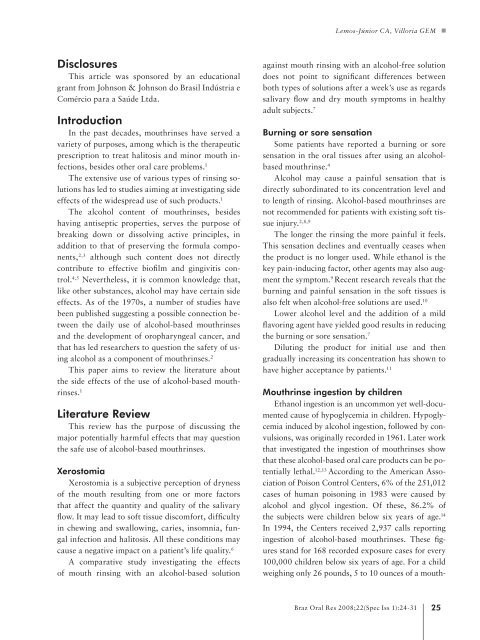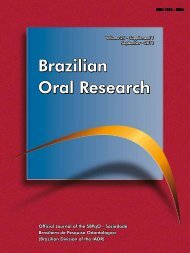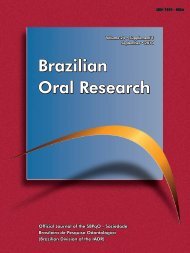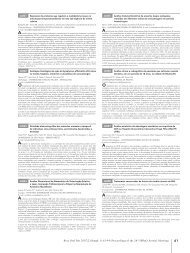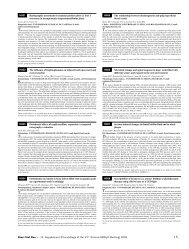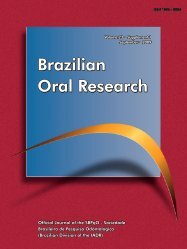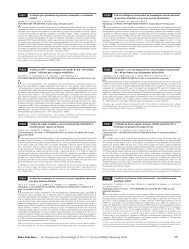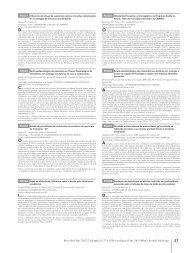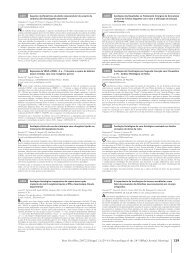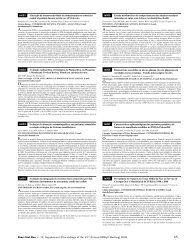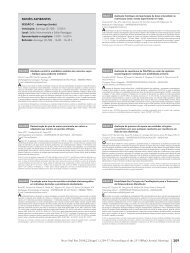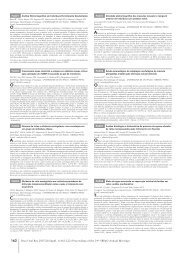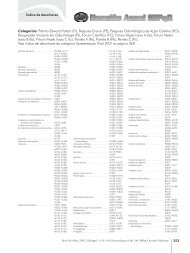Brazilian Oral Research Brazilian Oral Research Brazilian Oral
Brazilian Oral Research Brazilian Oral Research Brazilian Oral
Brazilian Oral Research Brazilian Oral Research Brazilian Oral
You also want an ePaper? Increase the reach of your titles
YUMPU automatically turns print PDFs into web optimized ePapers that Google loves.
Disclosures<br />
This article was sponsored by an educational<br />
grant from Johnson & Johnson do Brasil Indústria e<br />
Comércio para a Saúde Ltda.<br />
Introduction<br />
In the past decades, mouthrinses have served a<br />
variety of purposes, among which is the therapeutic<br />
prescription to treat halitosis and minor mouth infections,<br />
besides other oral care problems. 1<br />
The extensive use of various types of rinsing solutions<br />
has led to studies aiming at investigating side<br />
effects of the widespread use of such products. 1<br />
The alcohol content of mouthrinses, besides<br />
having antiseptic properties, serves the purpose of<br />
breaking down or dissolving active principles, in<br />
addition to that of preserving the formula components,<br />
2,3 although such content does not directly<br />
contribute to effective biofilm and gingivitis control.<br />
4,5 Nevertheless, it is common knowledge that,<br />
like other substances, alcohol may have certain side<br />
effects. As of the 1970s, a number of studies have<br />
been published suggesting a possible connection between<br />
the daily use of alcohol-based mouthrinses<br />
and the development of oropharyngeal cancer, and<br />
that has led researchers to question the safety of using<br />
alcohol as a component of mouthrinses. 2<br />
This paper aims to review the literature about<br />
the side effects of the use of alcohol-based mouthrinses.<br />
1<br />
Literature Review<br />
This review has the purpose of discussing the<br />
major potentially harmful effects that may question<br />
the safe use of alcohol-based mouthrinses.<br />
Xerostomia<br />
Xerostomia is a subjective perception of dryness<br />
of the mouth resulting from one or more factors<br />
that affect the quantity and quality of the salivary<br />
flow. It may lead to soft tissue discomfort, difficulty<br />
in chewing and swallowing, caries, insomnia, fungal<br />
infection and halitosis. All these conditions may<br />
cause a negative impact on a patient’s life quality. 6<br />
A comparative study investigating the effects<br />
of mouth rinsing with an alcohol-based solution<br />
Lemos-Júnior CA, Villoria GEM<br />
against mouth rinsing with an alcohol-free solution<br />
does not point to significant differences between<br />
both types of solutions after a week’s use as regards<br />
salivary flow and dry mouth symptoms in healthy<br />
adult subjects. 7<br />
Burning or sore sensation<br />
Some patients have reported a burning or sore<br />
sensation in the oral tissues after using an alcoholbased<br />
mouthrinse. 4<br />
Alcohol may cause a painful sensation that is<br />
directly subordinated to its concentration level and<br />
to length of rinsing. Alcohol-based mouthrinses are<br />
not recommended for patients with existing soft tissue<br />
injury. 2,8,9<br />
The longer the rinsing the more painful it feels.<br />
This sensation declines and eventually ceases when<br />
the product is no longer used. While ethanol is the<br />
key pain-inducing factor, other agents may also augment<br />
the symptom. 9 Recent research reveals that the<br />
burning and painful sensation in the soft tissues is<br />
also felt when alcohol-free solutions are used. 10<br />
Lower alcohol level and the addition of a mild<br />
flavoring agent have yielded good results in reducing<br />
the burning or sore sensation. 7<br />
Diluting the product for initial use and then<br />
gradually increasing its concentration has shown to<br />
have higher acceptance by patients. 11<br />
Mouthrinse ingestion by children<br />
Ethanol ingestion is an uncommon yet well-documented<br />
cause of hypoglycemia in children. Hypoglycemia<br />
induced by alcohol ingestion, followed by convulsions,<br />
was originally recorded in 1961. Later work<br />
that investigated the ingestion of mouthrinses show<br />
that these alcohol-based oral care products can be potentially<br />
lethal. 12,13 According to the American Association<br />
of Poison Control Centers, 6% of the 251,012<br />
cases of human poisoning in 1983 were caused by<br />
alcohol and glycol ingestion. Of these, 86.2% of<br />
the subjects were children below six years of age. 14<br />
In 1994, the Centers received 2,937 calls reporting<br />
ingestion of alcohol-based mouthrinses. These figures<br />
stand for 168 recorded exposure cases for every<br />
100,000 children below six years of age. For a child<br />
weighing only 26 pounds, 5 to 10 ounces of a mouth-<br />
Braz <strong>Oral</strong> Res 2008;22(Spec Iss 1):24-31 2


